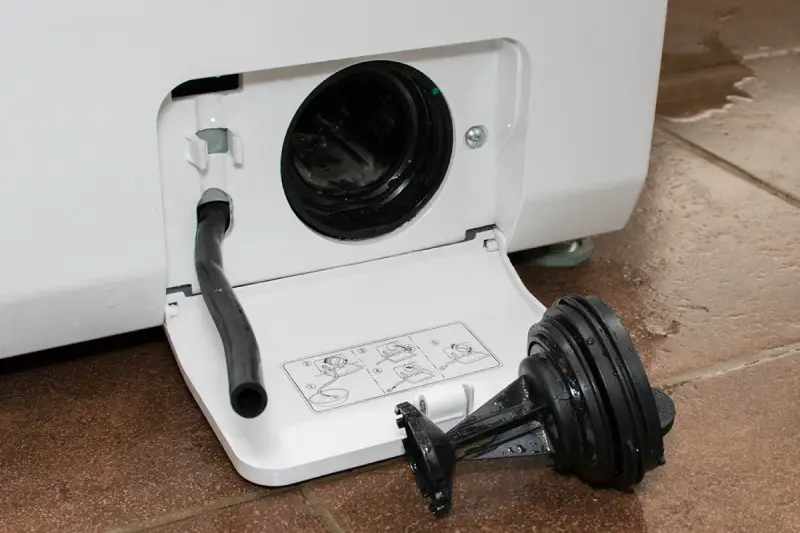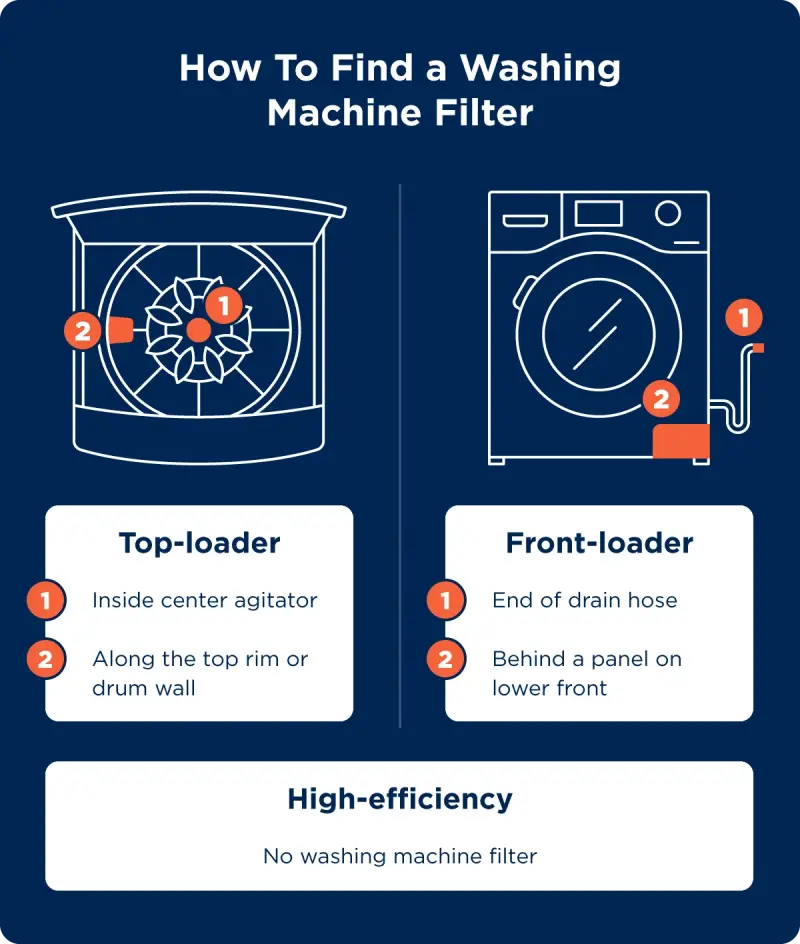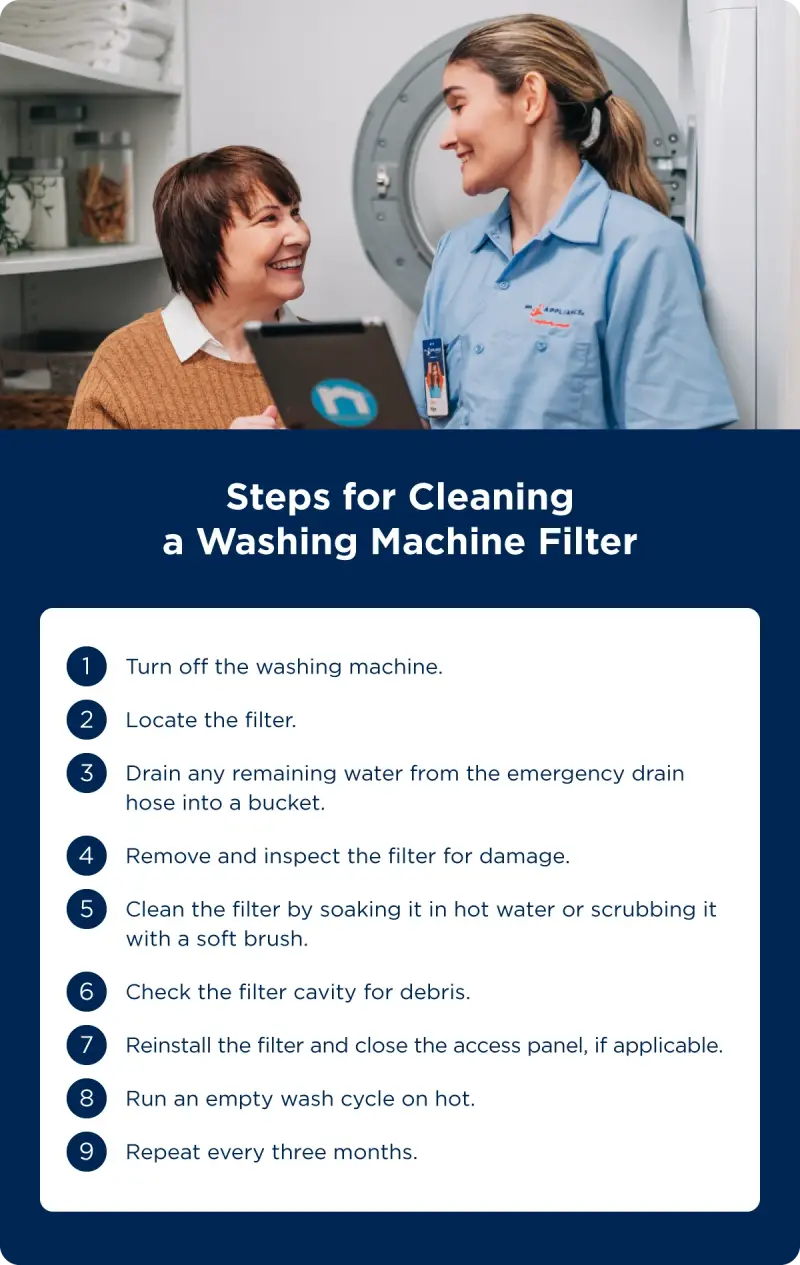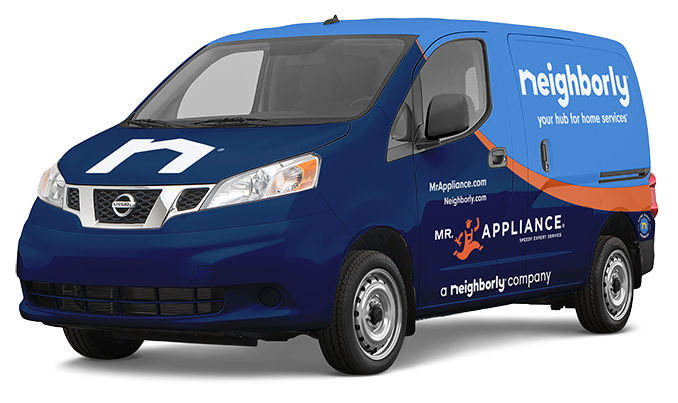
Mr. Appliance explains why cleaning your washer’s lint trap is essential for optimal performance and preventing clogs.
|
A washing machine filter acts as a lint trap to remove fuzz, hair, and other debris from your clothing and linens. Check inside or along the exterior of your washer to locate and determine if your machine has a filter. To prevent buildup and prolong your machine’s lifespan, clean your washing machine filter at least every three months.
You know to clean your dryer’s lint trap with every use, but did you know you may also have a washing machine filter that requires similar routine cleaning to prevent buildup? If your clothes come out of the wash with a light coat of lint, then your washing machine’s filter may already be clogged, and it’s time to clean it.
Some washing machine filters are removable, while other washers have mesh lint traps. Both styles serve the same purpose: to keep lint off your clothes and ensure good water drainage. However, only a clean filter or trap can do this.
Thankfully, you can easily fix lint and debris clogs, and we’re here to guide you through how to clean your washing machine filter.
Where Is the Washing Machine Filter?
The location of your washing machine’s lint filter depends on the age, brand, and whether it’s a front-load vs. top-load washing machine. Top-load washer lint traps are usually located inside the drum, whereas filters in front-loaders are typically accessed from the exterior. Some modern, high-efficiency machines may not have a filter at all.
Refer to the owner’s manual for specific instructions, or physically check the following areas based on your machine type — after you’ve turned your machine off.

Top-Loader Washing Machine Filter
You can typically find filters in top-loader machines in two places: inside the agitator or along the top lip of the tub. Here are tips on how to locate a washing machine filter in a top-load washing machine:
- Inside the center agitator: If you have a top-loading washer, inspect the center agitator. The cover may be removable, revealing a lint trap inside. It may look like a fully or partially enclosed cylinder with pinholes along the sides.
- Inside the top rim or along the washer drum: Use your fingers to feel around the top lip for a round or rectangular screen. You can remove this screen to brush off built-up lint. Move slowly to avoid jamming your fingers against the washer drum, and keep a good hold on the lid to prevent it from falling on your hand while you’re investigating.
Front-Load Washer Filter Location
Front-loader washing machine filters may be located in one of two places as well. Unlike top-loaders, you can typically access front-loading washer filters from the machine’s exterior. Here are the two places to check if you have this type of washer:
- On the front of the appliance: A cylinder filter may be hidden behind a small hatch on the machine's exterior. These are often located in the front bottom right corner.
- At the end of the drainage hose: A small mesh screen may be fitted onto the hose that drains water out of the machine.
High-Efficiency Washing Machines
If you have a high-efficiency (HE) washer — whether front- or top-loading — your machine likely doesn’t have a washing machine filter. Instead, it relies on a self-cleaning pump filter to remove lint from the wash. High-efficiency washers may not have lint traps, but the water pump filter can still get blocked. Here’s how to clean the pump filter:
- Run an empty wash or self-cleaning cycle once a month to flush excess lint from the pump filter.
- If you notice your clothes come out of the wash still dirty, check your water pump filter.
- Locate the small hatch on the lower front of the appliance.
- Open the hatch to remove anything that might be clogging the water pump filter, like buttons, coins, or even socks.
- Check the pump regularly for blockages to help your washer function properly.

How To Clean a Washing Machine Filter
If you notice lint on your freshly washed clothes or that your washing machine smells unpleasant, it’s time to inspect your washing machine filter for buildup. Routinely cleaning your filter will help with efficient washer operation, better drainage, and reduced lint deposits on clothes.
Here’s how to empty the lint trap in a washing machine:
-
Turn off the washing machine. Ensure your machine is not running before attempting to remove the filter. Better yet, unplug the machine first.
-
Locate the filter and remove the access panel cover. Refer to the owner's manual for specific instructions on your exact model. If you don’t have the manual handy, search the following areas for the filter:
- Top-loaders: Check along the top lip of the washer drum. If you don’t feel one along the rim, the filter may be inside the center agitator. Remove the fabric softener dispenser and agitator cap if your model has them.
- Front-loaders: Filters may be located behind a small hatch in the lower corner of the front of your machine or at the end of the drainage hose. The cover may have a push-to-release latch or require a thin tool like a coin to wedge open the door.
-
Place a dish or bucket underneath and drain any remaining water from the emergency drain hose. If your dish fills quickly with water, replace the cap and empty the dish. Repeat this process until the water stops flowing. Have a towel handy to clean any accidental spills. This step is only necessary for front-load washing machines.
-
Remove and inspect the filter. Unscrew or slide the filter out of its compartment. If your front loader has a mesh filter on the drain hose, you do not need to remove it. Look for debris and damage. Any buildup will be obvious, but be sure to check for cracks or broken parts carefully. If you identify any damage, schedule a washing machine filter replacement with your local Mr. Appliance®.
-
Clean the filter.
- For removable filters, soak the screen in a mixture of hot water and dish soap for 10 minutes to clear away built-up residue.
- For secured filters, clean away the lint with a soft brush.
- If the trap is disposable, replace it when it becomes clogged.
-
Check inside the filter cavity to see if your filter is removable. If the compartment has lint or sticky soap residue, use a soft brush to clean it out.
-
Reinstall the filter and close off the access panel. Slide or twist the filter back into place and return the cap or shut the hatch. Double-check that you’ve secured the emergency drain hose back to its position before closing, if applicable.
-
Run an empty wash cycle using hot water. If your machine has a pre-programmed cleaning cycle, you can run this instead.
-
Repeat at least every three months to remove the sticky layer of lint, detergent, and fabric softener from your washer lint trap.
If you still notice that your washer won’t drain or isn’t getting enough water, you may have a plumbing pressure issue. Contact your local Mr. Appliance to have it checked out.
Help Your Washing Machine Last Longer
Regular washing machine maintenance can help your appliance last longer and perform better. Make inspecting and cleaning your washing machine filter part of its routine care.
If you’re in need of washing machine repair or maintenance, your local Mr. Appliance® service professionals have the experience to get your machine — or any other household appliance — working properly again. Schedule a service online today, or give us a call.
We’re looking forward to providing you with outstanding service.
Frequently Asked Questions About Cleaning Your Washing Machine Filter
Mr. Appliance explains why cleaning your washer’s lint trap is essential for optimal performance and preventing clogs.
|
Decades of experience, highly skilled service professionals, and a commitment to exceptional customer service have made Mr. Appliance a trusted leader in appliance maintenance and repairs. Our commitment to keeping your appliances up and running includes using our many years of experience and expertise to answer your questions. Here are answers to some of the most frequently asked questions about washing machine repair.
Where is the washing machine filter located?/h3>
The washing machine filter is typically found along the bottom front panel of the machine or inside the agitator (for top-load models). Some newer machines have self-cleaning filters, but many still require regular manual cleaning. Always check your user manual for your model’s exact filter location.
How often should I clean my washing machine lint filter?
It’s a good idea to clean your washing machine lint filter every month—or more frequently if you do a lot of laundry. A clogged filter can lead to drainage problems, longer cycles, and even unpleasant odors. Keeping your washing machine filter clean can help extend your machine’s life and avoid costly repairs.
What happens if I don’t clean my washing machine filter?
Neglecting your washing machine filter can cause lint buildup, poor drainage, and mold growth. Over time, your washing machine may stop working efficiently—or stop working altogether. Regular cleaning helps prevent these issues. If your washer’s already acting up, your trusted appliance service professional can provide expert washing machine repair.
Can a clogged washing machine filter cause drainage issues?
Yes—a clogged washing machine filter is one of the most common causes of slow or incomplete draining. Lint, hair, and detergent buildup can block the flow of water, leaving clothes soaking wet at the end of the cycle. Cleaning your washing machine filter can solve the problem—but if it doesn’t, call your trusted appliance service professional for washing machine repair.
How do I clean my washing machine filter safely?
To clean your washing machine filter first, unplug the machine. Then, locate the washing machine filter, remove it, and rinse it under warm water to clear away debris. Be prepared for some water to spill out—placing a towel or shallow pan beneath the area can help. Need a hand? Your trusted appliance service professional can clean or replace the washing machine filter and inspect your washer.
This article is intended for general informational purposes only and may not be applicable to every situation. You are responsible for determining the proper course of action for your home and property. Mr. Appliance is not responsible for any damages that occur as a result of this blog content or your actions. For the most accurate guidance, contact the Mr. Appliance location nearest you for a comprehensive, on-site assessment.
